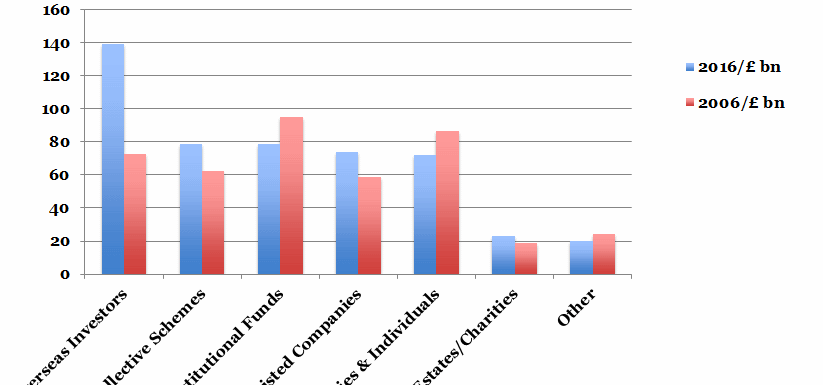Summary
Overseas investors saw the largest increase in UK commercial property ownership in the decade to 2016, with a 92% increase in property held. Overseas investors owned almost a third (29%) of total commercial property in 2016. The total property owned by UK investors in 2016 was worth £486 billion, some 55% of the UK total. Historically the biggest investor in UK commercial property, institutional funds’ (insurance companies and pension funds) ownership has decreased from 25% to 16% of the total in the decade shown. Unlisted property companies and private individuals experienced the same 17% decrease. There has also been significant increase in ownership by UK collective investment schemes and Real Estate Investment Trusts (REITs), both increasing by roughly a quarter. Traditional estates and charities, and other ownership types remained low over the decade. The figures shown exclude housing and student accommodation, an area dominated by large commercial property investors who owned almost £40 billion worth in 2016, a 30% increase from the previous year.
What does the chart show?
The chart shows the values of UK commercial property ownership in GBP billion. The categories are based on investor type. The blue bars represent values from 2016 and the red bars represent values from 2006. The data originates from the Property Insurance Alliance’s data report.
Why is the chart interesting?
Following the global financial crisis, investment performance of commercial property has been volatile and slower to recover than other financial markets. From 2006-2016, commercial property floorspace has grown by only 0.5%, whereas residential floorspace has increased by over 7%. Asset price inflation from quantitative easing has put upward pressure on rental costs and business rates. Business rates are linked to retail price index (RPI) rather than the consumer price index (CPI), meaning that business rates are increasing faster than price-inflation. This puts UK businesses under further pressure, discouraging investment in commercial property.
Additionally, major investors have shied away from riskier investments as a byproduct of the crash. Due to QE, bond yields have only decreased, making returns on commercial real estate increasingly attractive in comparison to other assets. In 2017, UK office spaces delivered an average return of 8.5%, while UK 10-year gilts yielded only 2.6%. With near zero interest rates post-crash, collective schemes and overseas investors have been incentivised to increase their investment in commercial property, as shown by the chart. We see institutional fund ownership decrease in the decade because institutions have moved from direct commercial real estate investment to the use of collective schemes and REITs in an attempt to diversify portfolios, reducing risk and increasing liquidity. The decrease in commercial property investment by unlisted companies and individuals can be attributed to general post-crash malaise, coupled with the erosion of retail property investment returns by the rise of e-commerce.
In contrast to the 2006-2016 data, patterns in domestic investment in commercial property have reversed since the referendum. Uncertainty surrounding the effects of Brexit has deterred foreign investment in many sectors across the UK economy, but especially in commercial property due to its vulnerability to decreases in consumer spending. This decline in retail spending has yet to take hold but remains a risk as the gap between wage growth and inflation widens. The Bank of England’s tightening of monetary policy may combine with a reduction in consumer confidence to negatively affect investment. Moreover, supply of larger assets that have previously attracted the most foreign investor interest has been relatively low. In the first seven months of 2018, there have been only 56 agreements of over £100 million, compared to 70 in the same period last year.
Despite many widely-reported store closures in recent months, rents on retail stores appear to be rising. However, leases are getting shorter and lease breaks more common, adding upward pressure to short-term rents. As interest rates have risen, owner-occupiers have been deterred from high-risk property acquisitions, particularly as mortgage affordability rules have remained restrictive. Some believe these negative factors to be outweighed by a favourable business environment. Theresa May recently asserted that ‘Whatever your business, investing in a post-Brexit Britain will give you the lowest rate of corporation tax in the G20.’
Week 40, 2018


